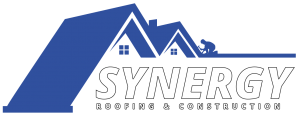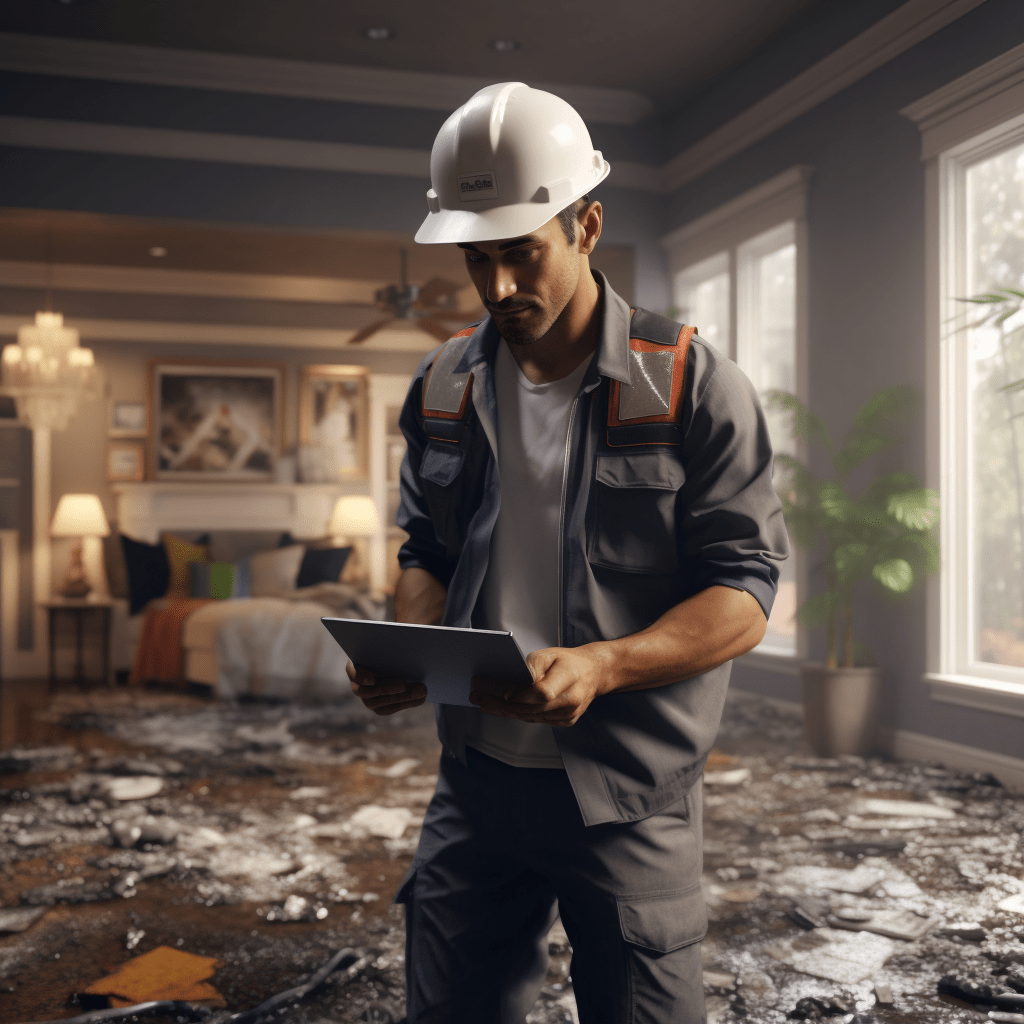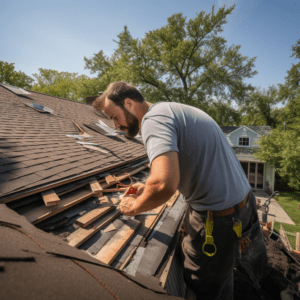Roof inspections play a crucial role in ensuring the structural integrity and longevity of buildings. Like a watchful eye, they provide a panoramic view of potential issues that may be hidden to the untrained observer. This article aims to inform readers about the importance of regular roof inspections, how to identify signs that necessitate an inspection, and tips for finding reliable roof inspectors nearby. Additionally, it will explore common roof problems discovered during inspections and emphasize the benefits of timely repairs and maintenance. Furthermore, this article will address frequency considerations when scheduling roof inspections and offer guidance on hiring professional roof inspectors.
Key Takeaways
- Regular roof inspections are essential for maintaining the structural integrity and longevity of buildings.
- Signs that indicate the need for a roof inspection include the age of the roof, leaks and water damage, loose or missing shingles, and sagging areas or visible signs of rust on metal roofs.
- Common roof issues found during inspection include cracked or missing shingles, damaged or improperly sealed flashing, clogged gutters and downspouts, leaks and water damage in the attic, and poor ventilation or insulation.
- Timely roof repairs and maintenance prolong the lifespan of the roof, prevent further damage, and reduce utility bills.
Importance of Regular Roof Inspections
Regular roof inspections are crucial for maintaining the structural integrity and longevity of a building. These inspections involve a thorough examination of the roof to identify any existing or potential issues. By conducting regular inspections, property owners can address problems in their early stages, preventing them from escalating into more significant and costly repairs.
During a roof inspection, various aspects are assessed to ensure optimal performance. The inspector examines the roofing materials for signs of wear and tear, such as cracks, blistering, or missing shingles. They also inspect the gutters and downspouts for debris accumulation or blockages that could hinder proper drainage. Additionally, they assess the flashing around chimneys, vents, and skylights to identify any leaks or deterioration.
Regular inspections allow for timely detection of issues such as water damage, mold growth, or structural weaknesses caused by weather conditions or aging. Addressing these problems promptly can prevent further damage to the building’s structure and interior components like ceilings and walls.
Furthermore, regular roof inspections play a crucial role in extending the lifespan of a roof system. Identifying small problems early on allows for prompt repairs or maintenance measures that can significantly prolong the life expectancy of the roof.
Signs You Need a Roof Inspection
Roof inspections are essential to identify signs of potential damage or deterioration. One key point to consider is the age of the roof, as older roofs are more prone to wear and tear. Additionally, leaks and water damage can indicate underlying issues that require immediate attention. Finally, loose or missing shingles may compromise the integrity of the roof and should be addressed promptly to prevent further damage.
Age and Deterioration
One important factor to consider when assessing the condition of a roof is the age and subsequent deterioration that may occur over time. The age of a roof is a crucial determinant in its overall condition and lifespan. As roofs age, they are exposed to various environmental factors such as sunlight, rain, wind, and temperature fluctuations that can cause wear and tear. Over time, this exposure can lead to the deterioration of roofing materials, including shingles, tiles, or metal sheets. Common signs of aging and deterioration include cracked or missing shingles, water leaks, sagging areas, or visible signs of rust on metal roofs. Regular inspections are essential to identify these issues early on and prevent further damage that could compromise the structural integrity of the roof.
Leaks and Water Damage
Leaks and water damage can cause significant structural issues and compromise the integrity of the building’s interior. When water infiltrates a building, it can lead to a range of problems, including deterioration of materials, mold growth, and electrical hazards. Water that seeps into walls, ceilings, or floors can weaken the structural components, such as beams and columns. This weakening can result in sagging or even collapse if left untreated. Furthermore, prolonged exposure to moisture can cause materials like wood to rot or warp, compromising their strength and stability. Additionally, water damage creates an ideal environment for mold growth, which not only damages surfaces but also poses health risks to occupants. Moreover, electrical systems exposed to water may become hazardous due to the increased risk of short circuits or electrocution. Regular inspections are essential for identifying leaks early on and preventing further damage to the building’s structure and occupants’ safety.
Loose or Missing Shingles
The presence of loose or missing shingles on a building’s exterior can leave the underlying structure vulnerable to various weather-related hazards. Shingles play a crucial role in protecting the roof from rain, wind, snow, and other environmental elements. When shingles become loose or go missing, they create gaps that allow moisture to seep into the underlying layers of the roof. This can lead to water damage, rotting of the roof deck, and even structural issues if left unaddressed. Additionally, loose or missing shingles can compromise the overall integrity of the roof system and reduce its ability to withstand strong winds. Regular inspections are essential to identify any signs of damaged or missing shingles promptly. Prompt repairs or replacements will help maintain a secure and durable roofing system for any building.
How to Find a Reliable Roof Inspector Near You
To locate a dependable roof inspector in your vicinity, it is essential to consider various factors such as their qualifications, experience, and customer feedback. When searching for a reliable roof inspector near you, it is imperative to verify their qualifications. Look for inspectors who have relevant certifications or licenses from reputable organizations related to the roofing industry. These credentials demonstrate that they have undergone training and possess the necessary knowledge to conduct thorough inspections.
Experience is another crucial factor to consider when selecting a roof inspector. Experienced inspectors are more likely to have encountered a wide range of roofing issues and can accurately identify any potential problems with your roof. They are also familiar with different types of roofs and can provide valuable insights into maintenance techniques or repair recommendations based on their past experiences.
Furthermore, considering customer feedback can give you an idea of the quality of service provided by the roof inspector. Look for reviews or testimonials on reputable websites or ask for references from previous clients. Positive feedback indicates reliability and professionalism.
What to Expect During a Roof Inspection
During a roof inspection, the inspector will conduct a thorough evaluation of various components to assess their condition and identify any potential issues. The inspection typically begins with an examination of the exterior of the roof, including the shingles or other roofing material. The inspector will look for signs of damage such as cracks, missing pieces, or curling. They will also inspect the flashing around chimneys, vents, and skylights to ensure it is properly sealed and in good condition.
Next, the inspector will examine the gutters and downspouts to ensure they are clear of debris and functioning properly. They will check for any signs of sagging or damage that could indicate drainage issues.
After examining the exterior, the inspector will move inside to evaluate the attic space. They will look for signs of leaks or water damage on insulation, rafters, and sheathing. Additionally, they may check for proper ventilation to prevent moisture buildup.
Finally, the inspector may inspect other components related to the roof’s performance such as ventilation systems or solar panels if applicable.
Overall, a roof inspection aims to provide a comprehensive assessment of a roof’s condition and identify any areas that may require repairs or maintenance.
Common Roof Issues Found During Inspections
When conducting a roof inspection, several common issues may be identified. One such issue is leaks and moisture, which can lead to water damage and mold growth if not addressed promptly. Damaged shingles are another concern, as they can compromise the integrity of the roof and increase the risk of leaks. Additionally, structural integrity concerns may arise during an inspection, including signs of sagging or weak support systems. It is important to address these issues promptly to prevent further damage and ensure the longevity of the roof.
Leaks and Moisture
One important aspect to consider in roof inspections is the presence of leaks and moisture. Leaks can pose significant problems if not addressed promptly, as they can lead to structural damage and the growth of mold or mildew. Moisture detection is crucial because it can indicate potential leaks or water infiltration that may not be immediately visible. Inspectors use various methods to identify leaks and moisture, such as visual inspection for signs of water stains or discoloration on ceilings or walls, thermal imaging cameras to detect temperature differences indicating hidden moisture, and moisture meters to measure the level of moisture within materials. These tools help ensure a thorough assessment of the roof’s condition and provide valuable information for necessary repairs or maintenance measures.
Damaged Shingles
Damaged shingles can be identified through visual inspection for signs of curling, cracking, or missing pieces, as these issues may compromise the integrity and functionality of the roof. Curling occurs when the edges of the shingles turn upward, while cracking refers to fissures or breaks in the shingle surface. Missing pieces indicate that some shingles have become dislodged or blown away. These problems can result from various factors such as aging, poor installation, extreme weather conditions, or inadequate maintenance. Damaged shingles can lead to leaks and water infiltration into the underlying roofing structure, causing further damage over time if left unattended. It is important to address any damaged shingles promptly to prevent structural issues and ensure the long-term durability of the roof.
Structural Integrity Concerns
Damaged shingles on a roof can lead to structural integrity concerns. When shingles are damaged, they no longer provide adequate protection against water infiltration and other environmental elements. This can result in moisture seeping into the underlying layers of the roof, potentially causing rot, decay, and weakening of the roof’s structure. Additionally, damaged shingles may compromise the overall stability of the roof by allowing wind uplift forces to affect its performance.
To assess structural integrity concerns in a roof, professional inspections are necessary. These inspections involve a thorough examination of the entire roofing system, including its supporting members such as beams and trusses. The inspector will look for signs of sagging or bowing, which could indicate structural weaknesses. They may also inspect the attic for any visible signs of damage or stress on load-bearing components.
Identifying and addressing structural integrity concerns is crucial to maintaining a safe and durable roof that can withstand various environmental conditions. Regular inspections can help detect these issues early on and prevent further damage or potential collapses that could endanger occupants and property.
Benefits of Timely Roof Repairs and Maintenance
Timely roof repairs and maintenance offer several advantages, including prolonging the lifespan of the roof, preventing further damage, and maintaining energy efficiency. By addressing issues promptly, roof repairs can significantly extend the lifespan of a roof. Regular inspections and maintenance allow for early detection of potential problems such as leaks or damaged shingles. Identifying these issues in their early stages enables homeowners to take appropriate action before they worsen. Neglected repairs can lead to more severe damages over time, requiring costly replacements or extensive renovations.
Furthermore, timely roof repairs can prevent further damage to not only the roof but also other areas of the house. Leaks or structural weaknesses in the roof can result in water infiltration, leading to rotting wood, mold growth, and compromised insulation. These secondary damages can be expensive to repair and may even pose health risks for occupants.
Moreover, maintaining energy efficiency is another benefit of timely roof repairs and maintenance. A well-maintained roof with proper insulation helps regulate indoor temperatures by minimizing heat loss in winter and heat gain in summer. This reduces reliance on heating and cooling systems, resulting in lower energy consumption and decreased utility bills.
How Often Should You Schedule Roof Inspections
Regularly scheduling roof inspections is essential to ensure the early detection of potential issues and maintain the structural integrity of a house. The frequency at which these inspections should occur depends on various factors such as the age of the roof, its type, weather conditions, and any previous repairs or maintenance carried out.
For newer roofs that are in good condition, an annual inspection may be sufficient. This allows for any minor issues or wear and tear to be identified before they develop into more significant problems. Additionally, an annual inspection can help identify any damage caused by extreme weather events such as storms or heavy snowfall.
However, older roofs or those that have experienced recurring issues may require more frequent inspections. In these cases, biannual or even quarterly inspections might be necessary to ensure timely identification and repair of any developing problems.
It is important to note that regular inspections are not only aimed at detecting visible damage but also involve a comprehensive assessment of the roof’s overall condition. This includes checking for signs of water infiltration, loose or missing shingles, damaged flashing, deteriorated seals around vents and chimneys, as well as inspecting gutters and downspouts for blockages.
Hiring a Professional Roof Inspector: Tips and Considerations
When hiring a professional roof inspector, it is important to consider their qualifications, experience, and reputation in order to ensure a thorough and accurate assessment of the roof’s condition. Qualifications play a crucial role in determining the expertise of an inspector. Look for individuals who have relevant certifications and licenses, such as those from organizations like the National Roofing Contractors Association (NRCA) or the International Code Council (ICC). These certifications demonstrate that the inspector has received proper training and possesses knowledge about industry standards and best practices.
Experience is another key factor to consider when selecting a roof inspector. Experienced inspectors are more likely to have encountered a wide range of roofing issues and can provide valuable insights into potential problems. It is advisable to inquire about the number of years an inspector has been in practice and whether they specialize in specific types of roofs.
Reputation also plays a significant role in evaluating the reliability of a roof inspector. Seek recommendations from trusted sources such as friends, family, or local contractors who have previously worked with them. Additionally, check online reviews and ratings on reputable platforms to assess customer satisfaction levels.




